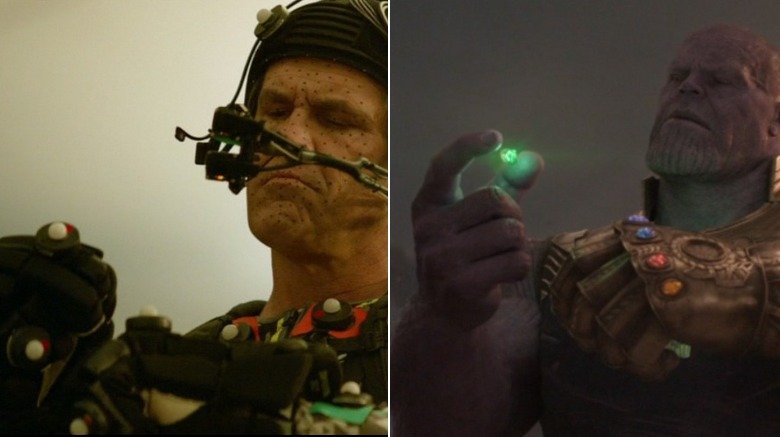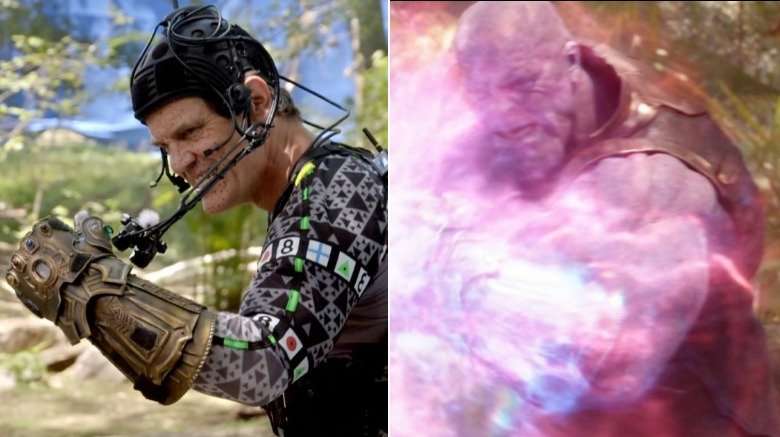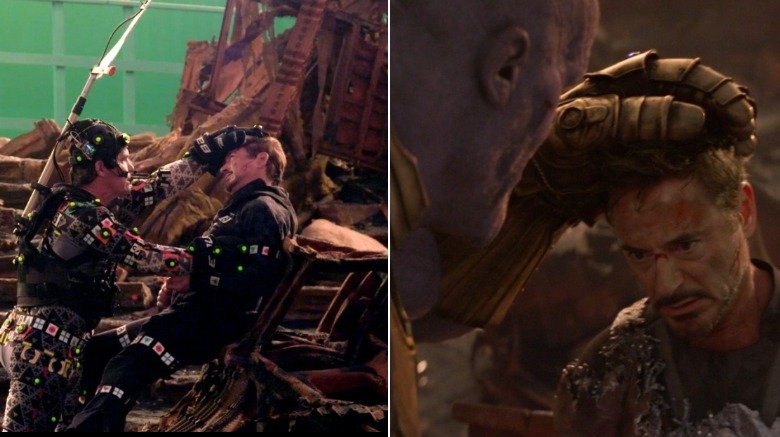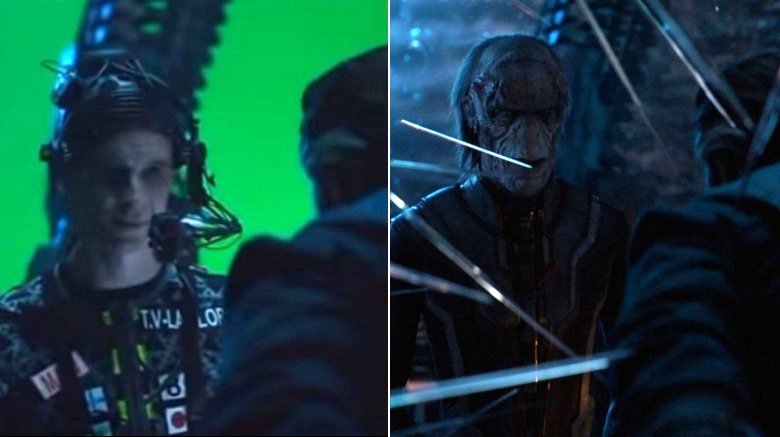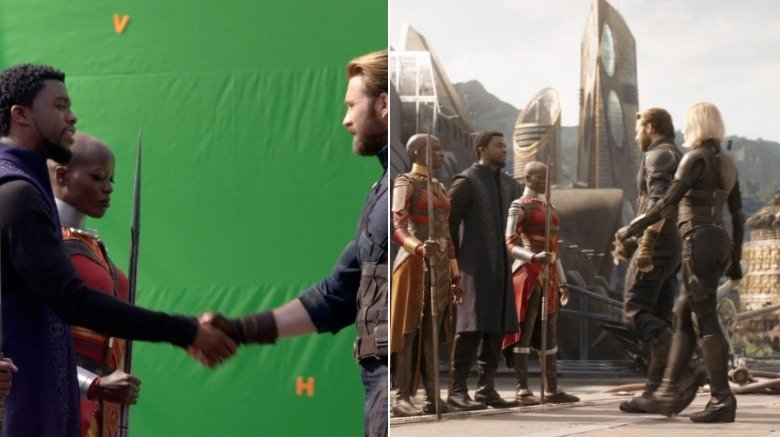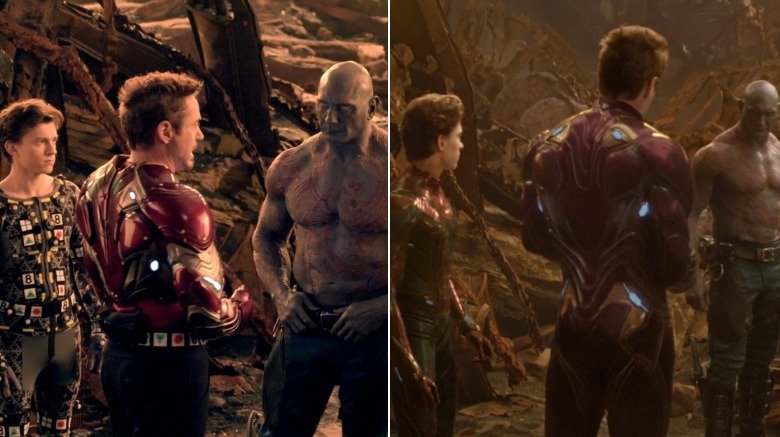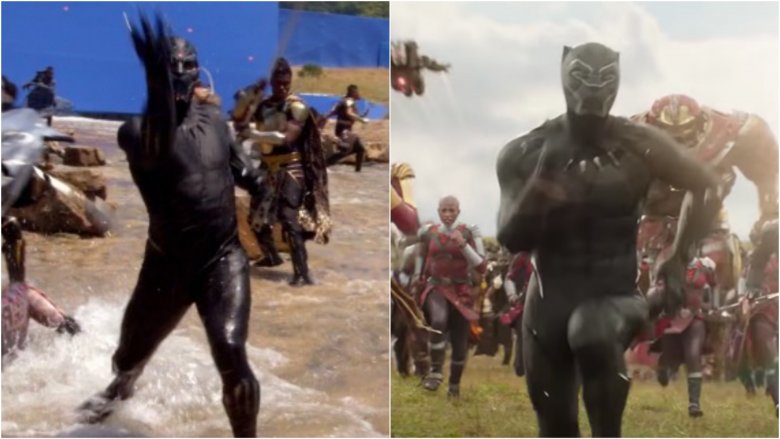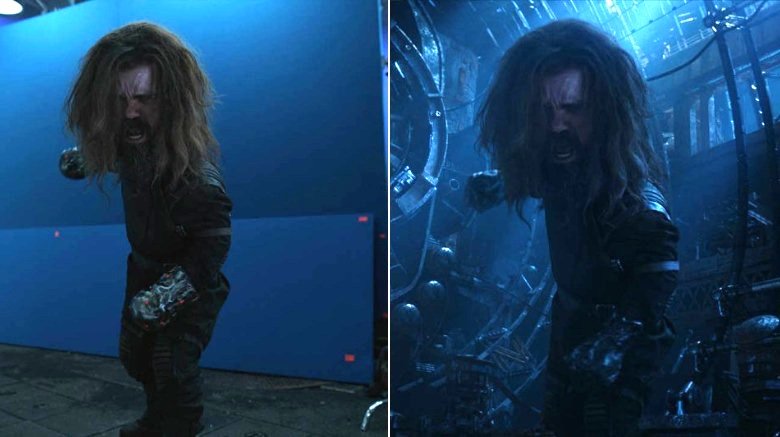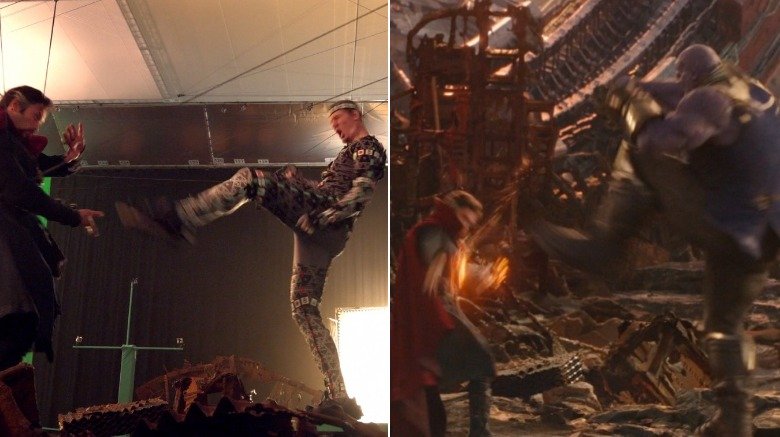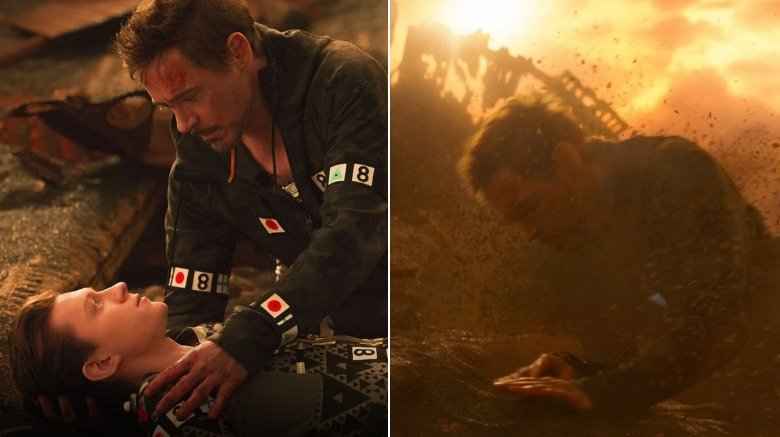What Avengers: Infinity War Looks Like Without The Special Effects
When you consider Superman debuted in 1938, it seems funny that it took so long for superhero films to become a major force in the entertainment industry. Of course, one of the chief reasons is no mystery: it took until the turn of the 21st century for filmmaking technology to truly catch up with the imaginations of comic book artists. In comic books, superheroes travel through underwater kingdoms, outer space, and alternate realities; characters can be medieval heroes, intergalactic cops, or bizarre monstrosities. There are no limits in comics because it doesn't cost any more to draw a crazy sci-fi or fantasy setting than it does to draw a perfectly mundane one — and that's definitely not the case in movies.
Making a movie like Avengers: Infinity War would've been next to impossible before the advent of CGI. The film's scope is massive, going back and forth through space, alien planets, the streets of New York City, and a fictional African nation. There's a talking raccoon, a talking tree, a dude with a nano suit, a Hulk, a Hulkbuster, pagan gods, wizards, a nazi space ghost, a bunch of alien psychopaths, a giant dwarf with metal hands, an army of vicious four-armed man-dogs, and a big purple maniac with a chin that looks like a giant potato chip. You could've done Avengers: Infinity War without CGI, but it would've been a comedy, whether you intended it to be funny or not.
To show you what we mean, here's what Avengers: Infinity War looks like without the special effects.
The making of a madman
In a film featuring more big names than a Kathy Griffin set, Josh Brolin's Thanos was the undisputed king. A huge part of what made Thanos so compelling was the VFX innovation that allowed Brolin's acting to survive the CGI to give us what is arguably the most ranged and subtle performance of a digitally rendered film character to date.
The responsibility of creating and handling Thanos was shared by Digital Domain and Weta Digital. The Digital Domain team created a two-step system to handle the Thanos facial work. A process called Masquerade digitally scanned Brolin's face and was able to teach itself details like the range of his facial expressions, then Masquerade recorded the facial and motion capture of Brolin's performance. The second step of the process, called Direct Drive, transferred the captured data to the digital Thanos. The process created a mapping algorithm between Brolin and Thanos that could, among other things, identify how Thanos' and Brolin's respective anatomies aligned.
Kelly Port, Digital Domain's VFX supervisor, said the work she was most proud of was capturing the "subtleties of [Brolin's] performance" — particularly in the scenes with Thanos and Gamora on Vormir, and later with the child Gamora after Thanos snapped his fingers. "It was so important to [capture those subtleties]," Port said, "and they were longer shots that had to convey a lot of emotion without much facial movement at all."
Tony's new toy
It's not exactly shocking that Avengers: Infinity War gives us a new Iron Man suit. Honestly, considering the rate at which Stark usually produces new suits, the only surprise is that his Infinity War suit is Mark 50 instead of Mark 549 (maybe he was too busy making new Spidey suits to keep up with his Iron Man quota). As Stark begins to explain to Bruce Banner before Ebony Maw knocks him across the city, the Mark 50 "bleeding edge" suit is the result of a new nano technology that allows Stark to arbitrarily form the armor's metal into different shapes (e.g. the very Voltron-esque shield and later the spike Stark forms during his melee with Thanos on Titan).
Patric Roos, Framestore VFX supervisor, told Art of VFX the Mark 50 gave his studio its most complicated challenge on the film. "Things like solidity and flexibility combined with a metallic material is challenging," Roos said, "as it can break the realism and can take the audience out of the moment." Framestore used the program Houdini to achieve what Animation Boss called Stark's "second skin."
Cinesite also worked on Iron Man, and VFX supervisor Andrew Morley said the animation work on both Iron Man and his protege Spider-Man was extensive. Morley said that during the battle with Thanos on Titan, "only the heads of Robert Downey Jr. and Tom Holland were live-action" while their bodies in their respective suits were "fully CG."
The Black Order
Of all the members of Thanos' merciless Black Order, we get to see and hear Ebony Maw the most. In fact, not counting the dead of the Asgardian refugee ship, Ebony Maw's face is the first we see in Avengers: Infinity War. That prominence made the Maw's realization on the screen a particularly tough challenge for Cinesite, the studio tasked with his creation. "His head literally fills the whole screen in some cases so there's nowhere to hide," Andrew Morley, Cinesite VFX supervisor, told Art of VFX. "We had to throw everything we had at it." Tom Vaughan-Lawlor, who played Ebony Maw, wore a full head camera during his performance to facilitate facial capture. The Maw is almost a foot and a half taller than Vaughan-Lawlor, so Cinesite "played around a lot" with the differences in proportion, particularly with Ebony Maw's stride length.
Another Black Order member whose creation was particularly problematic was Cull Obsidian — the Hulk-sized brawler who pairs up with Ebony Maw when they go after the Time Stone early in the film. But in the case of Obsidian, it was his design that posed the biggest challenge, and that job went to Framestore. "He has a massive torso, reasonably thin waist, huge thighs and a bunch of weapons," Framestore Animation Supervisor Nick Craven said. "How do you take a character who has aspects of a toy and keep him looking heavy and dangerous?" Framestore posed Obsidian in a way that de-emphasized his disproportionate silhouette. If eagle-eyed Reddit users are correct, he certainly looked dangerous enough to Captain Marvel.
Wakanda Forever
Indicative of Joe and Anthony Russo's fidelity to the overall Marvel Cinematic Universe narrative as well as their gift for world-building, the "Beyond the Battle: Wakanda" featurette on the home release of Avengers: Infinity War shows that scenes set in the fictional African nation were meticulously planned in terms of design and setting. The Russo brothers reached out to Black Panther director Ryan Coogler to take advantage of the world Coogler had already created.
"[Coogler] and his team had maps of Wakanda," Joe Russo says on the featurette. "That was very helpful to us so that we could look at where we wanted to place the battle, understand strategy." The battle with the monstrous outriders and the surviving members of the Black Order was filmed on location at a large ranch in Georgia. Infinity War's art department carved an artificial river and dressed the ground with trees and vegetation native to Africa. Plates and textures of African landscapes and skylines acted as background in exterior shots.
Titan
The entire Titan sequence was shot on a sound stage in Pinewood Studios. On the "Beyond the Battle: Titan" featurette on the home release of Avengers: Infinity War, you see the walls of the stage lined with green screen. Marvel VFX supervisor Don DeLeeuw said that the backgrounds in the Titan scenes were from plates shot in Chile.
According to Weta Digital VFX supervisor Matt Aitken, while Thanos struggled against the Avengers and Guardians to get his hands on the Time Stone, a completely different kind of time travel was at work — the demanding schedules of Hollywood stars. Just because we saw all the actors on the screen at once doesn't mean they were on set at the same time. Speaking to CNET, Aitken said, "Scheduling the A-list actors all at the same time meant that sometimes, when you think you're looking over Dr. Strange's shoulder onto Tony Stark, it might not actually be Benedict Cumberbatch's shoulder that you're looking over. That was purely for availability reasons."
The battle for the Mind Stone
According to the "Beyond the Battle: Wakanda" featurette on the Avengers: Infinity War home release, the filming of the Wakandan battlefield faced a lot of weather challenges that Chris Hemsworth apparently couldn't handle with his new hammer. Torrential downpours and subsequent mudslides weren't quite as annoying as a big purple alien with a magic glove, but it was annoying enough. Anthony Russo called the Battle for the Mind Stone "probably the most physically challenging thing that we've ever done," and his brother didn't jump in to disagree. Regardless, they managed to bring us the biggest and most impressive large-scale battle we've seen in the MCU.
On the featurette, Marvel VFX supervisor Dan DeLeeuw said there were 70 extras on set along with stunt doubles, who were digitally copied to make 500 Wakandan warriors face off against ten thousand of Thanos' vicious outriders. On the featurette you can see dozens of extras in motion capture suits, squaring off against Black Panther's loyal soldiers.
The making of Stormbreaker
According to Greg Steele, Method Studios' VFX supervisor, a team of 220 people from Method worked on Avengers: Infinity War for ten months. When you consider that Method's primary responsibility was the Nidavellir storyline — in which Thor, Rocket, and Groot travel together in the hopes of getting a weapon that can kill Thanos — you get an idea of just how massive the entire production of Infinity War must have been.
Based on concept art and designs given to them by Marvel Studios, Method created Nidavellir, the Guardians of the Galaxy's new ship and the escape pod Thor and friends took to the near-abandoned forge, and teenage Groot. Rocket was essentially the same digital character audiences saw in Guardians of the Galaxy Vol. 2, but Method was tasked in refining certain aspects, such as using a new system that allowed for the gun-toting curmudgeon's fur to move more realistically.
To help them make Groot believable as a teenager, Method used video recordings of Quin Roberts, the 15-year-old son of Animation Supervisor Keith Roberts. Steele said the reference was invaluable in capturing "the drooped head and long dangly arms of someone growing into their teenage body."
Peter Dinklage and Chris Hemsworth were filmed separately in forced perspective shots against blue screen, in order to create the illusion of Eitri's relatively giant size (and also because of "time challenges with the talent"). Method also created a digital double of Eitri, the dwarf's new metal hands, and Thor's eyepatch.
The battle for the Time Stone
According to Joe Russo on the "Beyond the Battle: Titan" featurette on the Avengers: Infinity War home release, the battle between the Avengers, the Guardians, and Thanos on Titan took months to prepare.
"[W]e were able to go a bit crazy," Weta Digital VFX supervisor Matt Aitken said about the Titan battle, and you could argue "a bit crazy" is a serious understatement. The Titan fight includes a stunning one-on-one showdown between Thanos and a powerful wizard, a spaceship crashing into the ground and slamming into Thanos, Peter Quill hopping on Dr. Strange's discs like the Frogger veteran he probably is, Iron Man getting chased around decaying alien structures by a swarm of violent birds, and — oh yeah — Thanos ripping a moon out of the freaking sky and throwing it at Tony Stark like it was a paternity suit.
Weta Digital CG supervisor Sean Walker said their job was made a lot easier in terms of the battle's choreography by "some well-thought-out [previsualization]." Likewise, Joe Russo said the mano-a-mano between Thanos and Doctor Strange was initially rendered in previs though the original sequence was twice as long. Russo said once they cut the Strange/Thanos battle in half, Weta Digital worked almost entirely off the digital previsualization with Benedict Cumberbatch's shots being the only human element that needed to be shot and added later.
After the snap
It can be jarring and even a little funny to see the pre-effects shots in effects-heavy films, especially when the scenes in question are particularly emotional. When you see Thanos holding up the head of a mortally wounded Tony Stark, except instead of Thanos it's Josh Brolin in a motion capture suit with a picture of Thanos' face attached to a rod above the actor's head, it can be tough to imagine how either Brolin or Robert Downey Jr. were able to take the scene seriously. Regardless, Weta Digital had no problem taking perhaps the most emotionally powerful scene in Avengers: Infinity War – the death of Spider-Man — so seriously that they had trouble watching it.
The effect that made it appear Peter Parker and so many other Marvel heroes dissolved into dust after Thanos' infamous snap — which the filmmakers named the "blip effect" – was handled by Weta Digital. The victims of the snap were first filmed alongside survivors. In a second take, the survivors were filmed alone. Then the victims of the first take were brought into the second take digitally, and the disintegrating effect was added.
Even for the VFX team, Peter Parker's death hit everybody right in the Feels. "Nobody at Weta could watch that," Matt Aitken, lead VFX supervisor at Weta Digital, told ScreenRant. "The first few times we watched that we all choked up." Thankfully, it appears Weta's professionals were able to fight through their tears long enough to help create the visual that helped define Infinity War's haunting conclusion.
